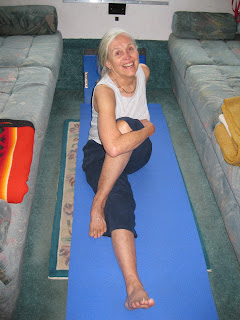That morning after our pancake breakfast we washed the gravel road dust off the RV, David bought an Alaskan fishing license for $145.00 and then we loaded up with $200.00 of food and supplies.
It was after 2 pm by the time we headed south on the Glenn Highway/Tok Cutoff, toward Anchorage. As soon as we were out of town we saw mountains on all sides, many rivers and streams and areas of marsh with concentrations of black spruce. The spruce trees are recognizable by their stunted growth and often crooked shape. Many of them have stubby clusters of branches at the top. The Milepost reports that the black spruce are generally found in poorly drained areas, such as wetland and permafrost, where white spruce will not grow.
Our free off-road site at Gulkana River
We parked overnight in an off-road site for the first time since we arrived in Alaska. Everyone told us you can park anywhere there isn't a sign saying "no camping", but we were a little reluctant to try it. David noticed RVs parked along the shore of the Glukana River, so we joined them. This is a very popular fishing spot and RVs and boats and fishermen were already in place, ready for the first salmon run. Seems like the whole State is holding its breath and waiting for the salmon to run.
The next day took us through Glennallen, the gateway to the Wrangell Mountains. It was overcast, so unfortunately we could not see any of the prominent peaks which would be visible on a clear day. I was interested to learn that Glennallen is the starting point and the finish line for the Copper Basin 300 Dog Sled Race. Some call this race "the toughest 300 miles in Alaska". This race is a qualifier for the Iditarod so it attracts both top mushers and first time rookies. (http://www.cb300.com/)
The Nelchina Glacier taken from the highway.
The road out of Glennallen gave us expansive views. I got all excited when I saw my first glacier. First I caught a glimpse of Tazlina Glacier in the distance, and then a quick view of the Nelchina Glacieras we drove past. I knew there was more to come and I could not wait!
As we approached the Matanuska Glacier David climbed on top of the RV to get a better look... and there it was!
The Matanuska Glacier.
There is a lovely viewing area set up so that travellers can get good photographs of the Matanuska Glacier. There is also a mile-long "Edge Trail" that leads you closer to the glacier. There are information panals along the way, and one of the most interesting told the story of Matanuska's fame. Because of the glacial dust, called loess, the land in this area is very fertile. As part of President Roosevelt's New Deal, some of the American farm families hit by the depression were relocated here. The population of the area around Palmer and Wasilla was rapidly increasing, and they needed a source for local food. The results were astounding. Cabbages weighed in at 105 lbs and one radish could reach 9 lbs ! The growing season here averages 100-118 days a year with long hours of sunshine, so that helps too. As a result, Palmer is the only community in Alaka that developed from an agricultural economy. Fresh vegetables from the Matanuska-Susitna Valley are still abundant and very popular.
David and I had been talking about meeting up with the Lazy Daze group with whom we started this trip.
From their itinerary we knew we had a good chance of meeting up with them, so we decided to head to Whittier and hopefully join them on a cruise of PrinceWilliam Sound for some more glacier viewing.
With Whittier in mind we drove through Palmer without a second look and skirted Anchorage. We drove south along the Turnagain Arm, off Cook Inlet, and felt new adventures coming our way. We stopped briefly in what the map called Portage....but what turned out to be only a train station. We learned that the whole town of Portage was destroyed in the earthquake of 1964 and the subsequent tsunamis. From there we drove down Portage Valley and found one of the best campgrounds we had seen in Alaska, The Williwaw USFS Campground.
When we are traveling from one destination to another with a goal in mind, our casual routine is interrupted and often our exercise suffers. So, I have learned to do a modified yoga routine between the coaches in the back of the RV. My music of choice now is Susan Boyles's I Dreamed a Dream. Many would question this choice because exercise music usually has a loud strong beat. However, I like Susan.
Her song Who I Was Born To Be is one of my favorites:
"And though I may not know the answers
I can finally say I'm free
If the questions led me here, then
I am who I was born to be."
A wonderful 94 year old friend of mine says it another way.....
"I am in the God place,
at the God time,
doing the God thing!"
































